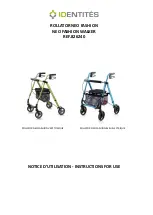
1
USER INSTRUCTIONS
SECURE FIT SLING RANGE
M29495
Small
M29501
Medium
M29513
Large
General Safety Warning
Please make sure that you read and follow these
instructions carefully. Keep these instructions in a
safe place for future reference.
Maximum User Weight
31st
200kg
1. INTENDED
USE
The Secure Fit Sling range is designed to suit a wide range of users and transfer needs. They can be used on hoists
fi
tted with a conventional spreader bar (i.e. with hooks at either end from which looped straps may be suspended).
If you are unsure about compatibility with the spreader bar contact NRS customer services, contact details overleaf.
2. SIZE
GUIDE
Sling Size
Small
Medium
Large
Colour Code
Sling Code
M29495
M29501
M29513
User Measurements
Shoulder to Sacrum
400-
550mm
15
3
⁄
4
-21
1
⁄
2
“
550-
700mm
21
1
⁄
2
-27
1
⁄
2
“
700-
800mm
27
1
⁄
2
-31
1
⁄
2
“
3. SAFETY
Warning:
The maximum user weight must not be more
than 200Kg (31st).
Persons using this equipment should have received
appropriate training or instruction.
Hoisting transfers should only be attempted following a
comprehensive risk assessment and should be performed
in accordance with local Moving & Handling Guidelines.
Before every lift, visually inspect the sling to ensure it is
fi
t for purpose. Refer to the Inspection Routine section of
this guide for the recommended method. If in doubt do
not use the sling.
4. UNPACKING
Remove the packaging and check all parts carefully.
Contact your supplier immediately if parts are missing or
damaged and do not try and assemble.
5. FITTING & OPERATIONAL INSTRUCTIONS
5.1
Fitting from the seated position
1. Place the sling behind the client with the top edge of
the sling level with the base of the client’s neck.
2. Position the sling by pulling the bottom edge briskly
from left to right and back again, the bottom edge
of the sling can be positioned 25-50 mm under the
client’s buttocks.
3. Pass the internal leg straps between the client’s legs
and thread the left loop through the right.
4. By pulling gently upwards on the external leg straps, it
should be clear that the client’s legs are fully enclosed
by the sling, with the straps crossed between the
client’s thighs. If this has not been achieved, undo the
straps and go back to step 3 and repeat.
5. Attach the shoulder straps to the hoist spreader bar.
(The middle loop on each shoulder strap will give a
reasonably upright sitting position.) A more reclined
position can be achieved by using a longer loop. For
a more upright posture choose a loop closer to the
sling.
6. Attach the leg straps to the hoist spreader bar. The
middle loop on each leg strap will give a reasonably
natural sitting position. The client’s knees can be
raised by selecting a loop closer to the sling.
7. Ensure that all loops are fully attached to the spreader
bar, and that the sling is well positioned and not
attached in any way to the seat or other obstacle.
8. Ensure client is secure and comfortable.
9. Raise the hoist spreader bar to lift the client just o
ff
the
surface. Check that all loops are connected and the
client is secure and comfortable prior to completing
the transfer.
10. Do not attempt to adjust or detach any strap while the
patient is being hoisted.
5.2 Fitting from the Lying position
Roll the client onto the sling, ensuring that the top edge
of the sling is level with the base of the neck, and the
bottom edge is positioned just below the coccyx. Follow
the instructions from point 3 of Section 5.1.
6. INSPECTION
INFORMATION
The following notes are a guide to the recommended
inspection procedures for slings.
If carried out thoroughly, at regular intervals, lifting and
hoisting operations can be carried out with con
fi
dence,
and the risk of injury due to sling failure is signi
fi
cantly
reduced.
Before every lift, visually inspect the slings structural
integrity. Use the diagrams below as a guide. If there are
any signs of damaged fabric or stitching do not use.
If you are unsure, do not use the sling, withdraw from
service immediately. The product should then be either
discarded, or clearly labelled: “Not for use” and assessed
at the earliest opportunity by a competent individual.













